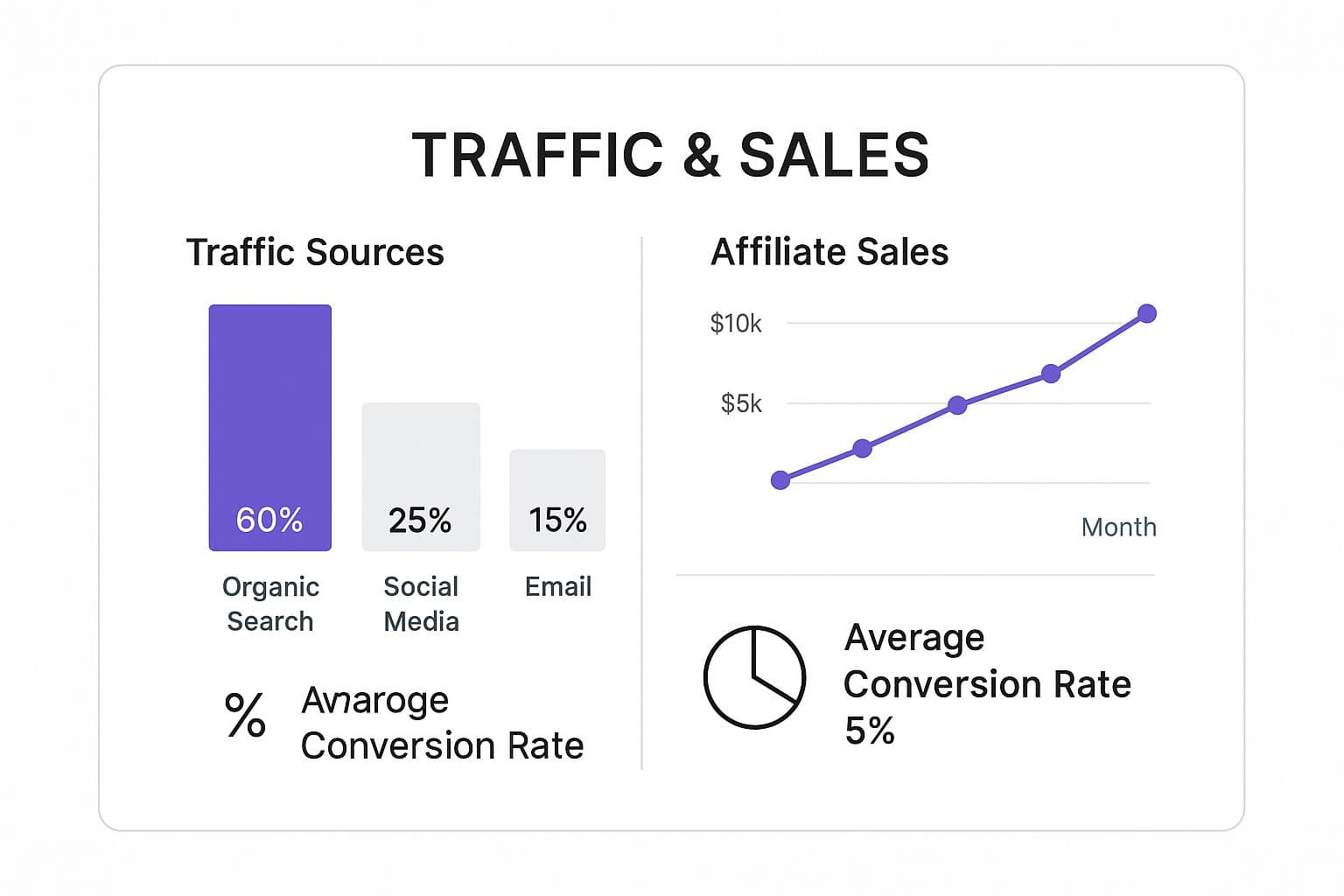How to Increase Affiliate Sales and Boost Your Income

To increase your affiliate sales, you must stop thinking like a link-dropper and start acting like a trusted advisor. The real money isn't in chasing the highest payout; it's in promoting products that solve real problems for your audience. That's the actionable path to building a loyal following that trusts your recommendations and, in turn, a sustainable income stream for the long haul.
Build a Foundation for Sustainable Affiliate Growth
Trying to boost affiliate sales without a solid strategy is like building a house on sand. You might get a few quick wins, but it's not going to last. The secret is to shift your entire mindset. Stop being just another promoter and become an indispensable resource for your community. This shift is what builds the authority you need for consistent, long-term affiliate revenue.
The affiliate marketing world is booming for a reason. It was valued at around $18.5 billion in 2024 and is on track to hit nearly $31.7 billion by 2031. Think about that—over 80% of advertisers now rely on affiliate marketing to find new customers. It's a proven, performance-based powerhouse.
This chart really drives the point home. It shows how a smart, balanced strategy—one that combines strong organic traffic with targeted social media and email marketing—creates steady, predictable sales growth and a healthy conversion rate.

The lesson here is crystal clear. By doubling down on what’s already working for you, like your organic search traffic, while also nurturing other channels, you can realistically double your monthly revenue in just six months.
To get there, you need to focus on the right things. I've broken down the core strategies into a simple table that shows where to put your energy.
Core Pillars for Boosting Affiliate Sales
This table summarizes the foundational strategies you need to implement. Focusing on these key areas will set you up for success and help you effectively increase your affiliate commissions.
| Strategy Pillar | Actionable Focus | Why It Works |
|---|---|---|
| Product Curation | Select products that align with your audience's genuine needs and reflect your brand's values. | Builds trust and credibility, making your recommendations more impactful. |
| Partnership Vetting | Thoroughly research potential partners for reputation, product quality, and affiliate support. | Protects your reputation and ensures a positive experience for your audience. |
| Audience Trust | Prioritize providing authentic value and solving problems over simply making a sale. | Fosters a loyal community that is more likely to convert over the long term. |
These pillars aren't just a checklist; they're a mindset. When you build your affiliate strategy around these fundamentals, you create a system that grows naturally and profitably.
Choose Products with Purpose
Your first move is to curate a portfolio of affiliate products that feels completely authentic to your brand. It's tempting to jump on every high-commission offer that lands in your inbox, but that's a shortsighted game. Instead, stop and ask yourself: does this product truly solve a problem for my audience?
To get a feel for how a well-structured partnership works in the real world, you can explore an example affiliate program and see how they lay out the terms and benefits. A product chosen with care not only solves a problem but also reinforces your credibility every time you mention it.
Your product selection is a direct reflection of your brand's integrity. The fastest way to build the trust you need for conversions is to promote solutions you genuinely believe in.
Vet Your Partners Thoroughly
Let's be honest: not all affiliate programs are created equal. Before you commit to a partnership, you have to do your homework. A company with a shoddy reputation, terrible customer service, or a low-quality product can tarnish your own credibility just by association.
Here's a practical checklist to vet any potential partner:
- Company Reputation: Check reviews on third-party sites like G2 or Trustpilot. What are real customers saying about their experience? This is your first red flag detector.
- Product Quality: Whenever possible, get a trial or demo of the product. Use it yourself. An honest, hands-on review is infinitely more powerful than a generic promotion.
- Affiliate Support: Does the program have your back? Look for helpful resources, a history of timely payouts, and a responsive affiliate manager. A good partnership is a two-way street.
This vetting process isn't just about protecting yourself; it’s about protecting your audience. When you build relationships with reliable companies, you create a foundation of trust that ultimately drives sustainable growth.
Become the Trusted Advisor Your Audience Needs

Here’s the thing about affiliate marketing: your audience’s trust is the engine behind every single conversion. If you're still relying on the hard sell, you're leaving money on the table. The real path to growing your affiliate sales is paved with authenticity and genuine connection.
You need to stop being a salesperson and start being a trusted guide. This practical shift is what makes all the difference for long-term success. The core of this is learning how to build credibility and become a trusted expert. Once your audience sees you as a reliable source, they'll actually listen to what you recommend.
Craft Unbiased and In-Depth Reviews
One of the most effective ways to build trust is through brutally honest and detailed product reviews. People are tired of one-sided, glowing promotions. They can spot a sales pitch from a mile away and are hungry for real-world insights.
For example, if you're reviewing a project management tool, don't just list its features. Show how you used it to manage a real project. And here’s the most important part: be transparent about its flaws. Pointing out a product’s weaknesses makes your praise of its strengths that much more powerful and believable.
A high-converting review follows a simple, actionable structure:
- The Problem: Start by clearly defining the challenge your audience is up against.
- The Solution: Position the product as a potential fix for that specific problem.
- The Experience: Share your hands-on story—the good, the bad, and the ugly of using it.
- The Verdict: Give a final, balanced recommendation on who this product is for (and who it isn't for).
This structure proves you’ve done your homework. It shows you care more about helping your audience make a smart decision than you do about just pocketing a commission.
Tell Personal Stories to Forge a Connection
Facts and figures inform, but personal stories connect emotionally and drive action. Sharing your own experiences—your struggles, your wins, and the lessons you learned along the way—is an incredibly effective way to boost affiliate sales without ever feeling pushy.
People want evidence, not just opinions. Sharing a personal case study or a "before and after" scenario provides the social proof needed to turn a hesitant browser into a confident buyer.
For instance, instead of just claiming a web host is "fast," tell the story of how your website's terrible load times were costing you business. Walk readers through the migration process and then show them the tangible results—the improved loading speed and better user engagement. That kind of narrative is infinitely more persuasive than a generic feature list.
When you weave these strategies into your content, you change the entire dynamic from a transaction to a relationship. Building that foundation of trust isn't just a nice-to-have; it's absolutely essential if you're serious about affiliate marketing. As your own program matures, you might even want to learn how to recruit affiliates who embrace this same authentic style.
Dial In Your Content and SEO to Capture Buyer Intent

Look, creating incredible content is a huge part of the puzzle, but it's not the whole game. If the right people—the ones with their credit cards out—can't find it, your affiliate links will just collect dust. To really increase affiliate sales, you have to get serious about an SEO strategy that laser-focuses on visitors who are ready to buy, not just window shopping.
This means you must move past broad, high-volume keywords. The real money is in the phrases that signal buyer intent. These are the exact search queries people use when they're actively trying to solve a problem and are on the verge of making a decision. For affiliate marketers, finding these keywords is like striking gold.
Find and Target High-Intent Keywords
Your keyword research needs to be surgical. Targeting a broad term like "project management software" is a waste of time. You need to dig much deeper to unearth the phrases people use when they're seriously weighing their options.
Put yourself in your customer's shoes. What are they typing into Google when they’re close to a decision? High-intent keywords almost always include modifiers that signal they are ready to buy. Here are the types of keywords to target:
- Comparisons: "[Product A] vs [Product B]"
- Reviews: "[Product Name] review"
- Best Of: "best CRM for small business"
- Alternatives: "[Competitor] alternatives"
- Discounts: "[Product Name] discount code"
Use tools like Ahrefs or Semrush to find these specific, long-tail phrases. When you build content around them, you attract a far more qualified audience that is looking for that final, expert nudge to make a purchase.
A winning affiliate SEO strategy is built on empathy. You have to get inside your reader's head and create the exact content they are desperately searching for at the moment they are most likely to buy.
Structure Your Content to Convert
Once you've nailed down your keywords, the structure of your content is critical. Two formats consistently outperform all others for driving affiliate commissions: "best of" roundups and in-depth comparison posts.
A "best of" article should list the top tools for a specific need. For each, provide a quick summary, highlight its key features, and place your affiliate link within a clear call-to-action. This format helps readers quickly sort through their best options in one place.
A comparison post is a deep-dive battle between two or three competitors. Get granular on pricing, features, usability, and support. Use simple comparison tables to help readers digest the information quickly. This head-to-head analysis builds incredible trust and positions you as the go-to expert, making people feel confident when they click your link.
Getting these SEO tactics right is a skill that pays dividends. It’s no surprise that 69% of affiliate marketers use SEO to generate traffic, making it the most reliable growth channel. What’s more, there's a clear line between experience and income here—top earners who’ve been in the game for over a decade credit their success to mastering these skills. You can see more affiliate marketing statistics from Wix to get a better sense of the potential.
Don't Put All Your Eggs in One Traffic Basket

I’ve seen it happen too many times: an affiliate marketer is crushing it with one traffic source, and then a sudden algorithm update or policy change completely tanks their income overnight. Relying on a single channel is a huge gamble. If you want to build a truly resilient and scalable affiliate business, you have to diversify.
This doesn't mean you need to master every platform at once. The actionable step is to build a solid engine with a few different channels working together, each playing to its unique strengths. This approach insulates your business from platform volatility and opens up entirely new streams of revenue.
The affiliate world today is a mix of different channels for a reason. You've got over 75% of affiliate marketers using social media like Facebook, while at the same time, 27.8% of brands still swear by blogs for their SEO power. This data just confirms what experienced marketers already know: a blended strategy is key. If you want to dig deeper, you can explore more affiliate marketing channel preferences to see just how effective this is.
Match Your Promotions to the Platform
A promotion that works wonders on your blog will likely fall flat on Pinterest. You can't just copy and paste. To truly increase affiliate sales, you need to tailor your message to the platform you're on.
Here’s an actionable breakdown:
- Your Blog: This is your home base for authority. Create SEO-optimized content like "best of" lists, comprehensive product comparisons, or "how-to" guides that solve a real problem.
- YouTube: This is where you show, not just tell. Record video reviews, tutorials, and unboxing videos. Demonstrating how a product works builds a level of trust that text alone can't match.
- Pinterest: Treat this as a visual discovery tool. Create eye-catching, vertical Pins that make people stop scrolling. Use "before and after" images, helpful infographics, or aesthetic product shots that link back to your detailed blog reviews.
Build Your Most Valuable Asset: An Email List
Let’s be clear: traffic from social media and search engines is rented land. Your email list, on the other hand, is an asset you completely own. It's your direct line to your biggest fans, with no algorithm getting in the way.
If there's one thing to take away, it's this: Your email list is the most reliable and profitable channel for driving affiliate sales. It's where you build relationships and promote offers directly to people who want to hear from you.
Start building your list from day one. Offer a genuinely useful lead magnet—a free checklist, a short e-book, or a mini-course—in exchange for an email address. This isn't just about getting emails; it's about attracting an audience that's truly interested in what you have to say.
Once they're on your list, send them a mix of valuable, non-salesy content and well-timed promotions. This direct relationship is where the real magic, and the highest conversions, happen.
Time to Scale: Advanced Tactics for Serious Affiliate Revenue
Once you've got a steady affiliate income trickling in, it's time to think bigger. How do you go from a side hustle to a full-blown business? This is where top earners separate themselves. They use a specific set of strategies to multiply their revenue without a massive increase in effort.
This is about engineering better results. You'll need to get cozy with your data, understand your true value to your partners, and get smarter about how you connect with both your audience and the brands you represent.
Go Ask for a Raise: Negotiating Higher Commissions
If you consistently drive high-quality sales for a partner, you are a valuable asset. And you deserve to be paid like one. Many affiliate programs have unpublished, higher commission tiers for top performers. Be proactive and ask for that bump.
Before you email your affiliate manager, gather your data to build a solid case. Your email should include:
- Sales Volume: State the exact number of sales you drive each month.
- Conversion Rate: Show them that your traffic converts at a high rate.
- Customer Quality: Highlight low refund rates or high average order values. This proves you're sending them valuable customers.
When you can prove your worth with hard data, it’s no longer a request—it’s a business negotiation. A well-argued email showing your performance can easily lead to a 10-20% bump in your commission rate.
Make Your Offer the Only One That Matters with Custom Bonuses
Want a surefire way to increase affiliate sales? Make your offer the absolute best deal on the internet. You do this by creating a custom bonus that people only get if they buy through your link. This simple move can skyrocket your conversion rates because it gives customers a compelling reason to choose your link over anyone else's.
The key is relevance. Your bonus must be a natural extension of the product. For instance, if you're promoting a project management software, create bonuses like:
- A set of pre-built project templates.
- A mini-course on using the software's most powerful features.
- An exclusive "quick start" checklist for new users.
A great bonus bundle makes buying through your link a total no-brainer. It changes the customer's mindset from "Should I get this product?" to "I need to get this product through this link to score all these extras."
This isn't just a sales trick; it builds your authority and makes your brand more memorable. For anyone new to this, getting these business fundamentals right is crucial. You can dive deeper into setting up a solid foundation in our guide on how to start an affiliate marketing business.
Let Your Data Show You the Money
Your analytics dashboard is a treasure map. You're sitting on a goldmine of information that tells you exactly what's working and what's not. Applying effective Conversion Rate Optimization tips is a game-changer here, helping you turn more of your existing visitors into paying customers.
Dig into your numbers. Pinpoint the exact pages, content styles, and traffic channels that bring in the most cash.
You might find that a single, detailed product comparison post is generating 60% of your total affiliate income. That's your data telling you precisely what to do next: create more comparison posts, push that winning article in your email newsletter, or even run paid ads directly to it. By focusing your time and money on what's already proven to work, you can scale your revenue the smart way.
Common Questions About Increasing Affiliate Sales
We hear the same questions over and over from affiliates hitting a wall with their revenue. How do I actually move the needle?
Let's cut through the noise. This isn't theory; these are straight answers and practical tactics you can put to work right now to get your sales climbing.
How Can I Improve My Conversion Rates?
Getting more clicks is great, but turning those clicks into sales is where the money is. If your conversion rate is low, you're leaving cash on the table.
Here are three actionable optimizations that deliver real results:
- Make Your CTAs Obvious: Place clear, compelling call-to-action buttons right next to the benefits you've just described. Use action-oriented text like "Get Started Now" or "Try [Product] Today."
- Sweeten the Deal with a Bonus: What can you add that no one else is offering? Custom templates, a short video tutorial, or a mini-course can be the one thing that convinces a hesitant buyer to click your link.
- Never Stop Testing: You have to know what works. Pit one landing page variation against another with simple A/B tests. Track your conversion rate in your analytics to see exactly which version wins.
A tiny tweak to a headline or button color might seem insignificant, but I've seen changes like these produce a 15-25% lift in conversions. It all adds up.
When you track these metrics, you’re no longer guessing. You know exactly where your efforts will pay off the most.
How Often Should I Refresh My Content?
Stale content kills momentum. To keep your traffic and sales growing, you need to keep your content fresh. Think of it as tuning up your engine.
Here is a practical schedule for updating your top-performing content:
| Content Type | Update Frequency | Typical Impact |
|---|---|---|
| Evergreen Guide | 6-12 months | +20-30% Traffic |
| Comparison Post | 3-6 months | +15-25% Conversions |
| Listicle Article | Quarterly | +10-20% Engagement |
Updating your content does more than just please Google; it shows your audience (and your affiliate partners) that you're on top of your game.
What Tracking Tools Should I Use for Scaling?
As your affiliate program grows, you absolutely need the right tools to see what’s happening. Flying blind is a recipe for disaster.
Implement this core toolkit to get started:
- Google Analytics: This is non-negotiable. Use UTM tagging to track clicks from specific campaigns and understand where your traffic is coming from.
- Affiliate Platform Dashboard: This is your command center. Check it daily to monitor real-time sales and see which of your partners are performing best.
- CRM or Email Platform: Use a tool like Mailchimp or ConvertKit to segment your audience and send targeted promotional emails.
When you combine these, you get a 360-degree view of your performance. You can spot opportunities and plug leaks before they become major problems.
If you want to go deeper on this, our guide on affiliate marketing program management is the perfect next step.
Scaling isn't about working harder; it's about building smart systems, trusting your data, and being consistent.
What Common Mistakes Hurt Affiliate Growth?
It's frustrating to see affiliates make the same unforced errors that stall their growth. More often than not, it comes down to a few bad habits.
Skipping tests or ignoring your data is like trying to drive with your eyes closed.
Here are a few pitfalls to avoid:
- Putting All Your Eggs in One Basket: Relying on a single traffic source is incredibly risky. One algorithm change can wipe you out overnight. Diversify across a blog, email, and at least one social channel.
- Being Too "Salesy": If your content is just a thinly veiled ad, people will see right through it. Follow the 80/20 rule: provide 80% genuine value and 20% promotion.
- "Set It and Forget It" Link Strategy: Not tracking link clicks and conversions is a huge mistake. Regularly check your affiliate links to ensure they work and track performance to see what's driving results.
Answering these common questions should give you a much clearer path to increasing your affiliate sales.
Ready to streamline your affiliate management and boost your commissions? Discover how Push Lap Growth can help you scale. Get started today at https://pushlapgrowth.com
Learn more about its robust tracking, flexible commission structures, and affiliate portal.
Start your free trial or book a personalized demo to see results firsthand.
Grow revenue predictably with powerful affiliate tools today.